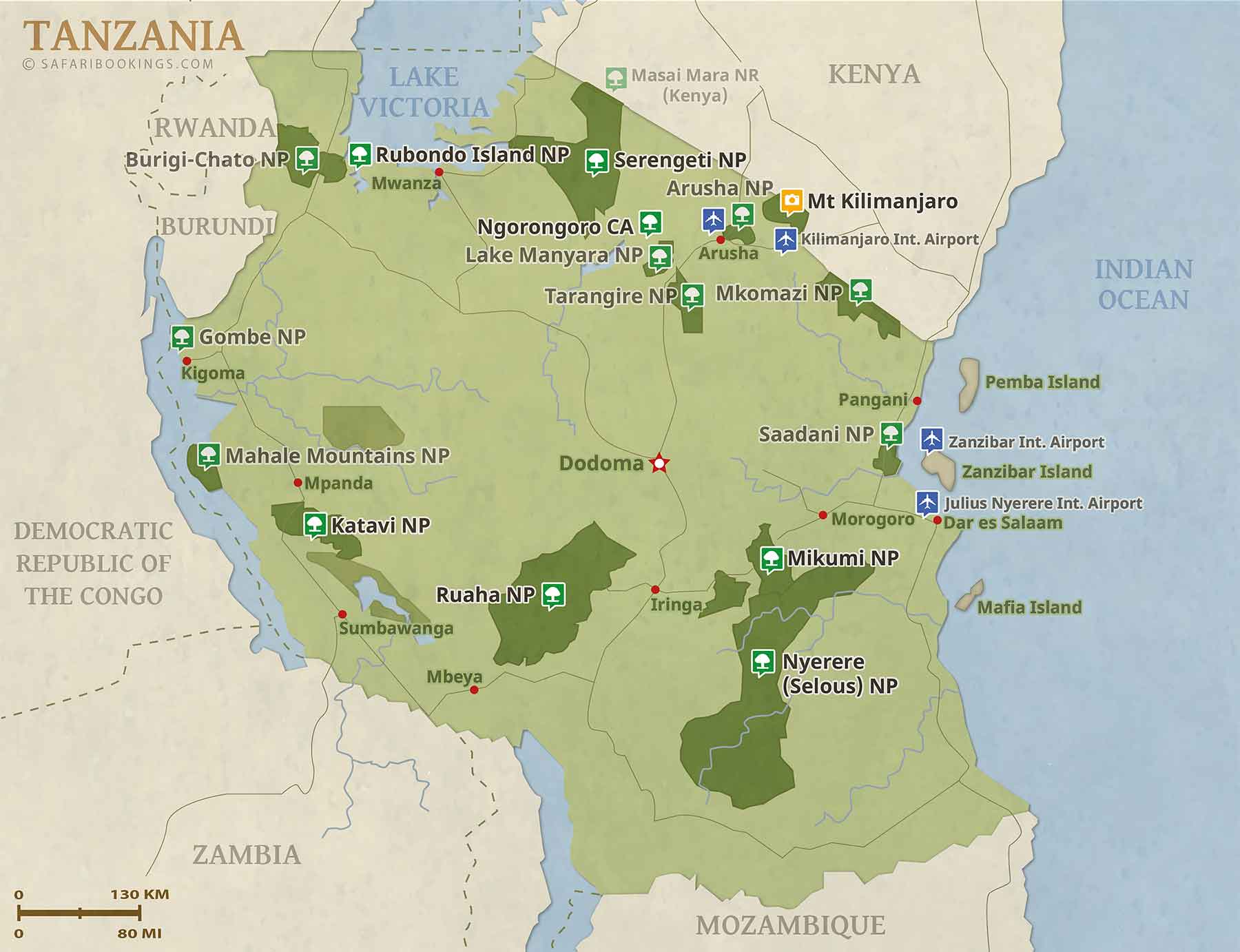Tanzania, with its three safari circuits, is one of Africa’s top wildlife destinations. The popular Northern circuit incorporates bucket-list landmarks such as Serengeti National Park, Ngorongoro Crater and Mt Kilimanjaro. Repeat visitors might prefer the remote wilderness vibe of the Southern or Western circuits. For some beach time, the ‘Spice Island’ of Zanzibar is only a short flight away.
The best time to visit Tanzania is during the Dry season, from June to October, when wildlife viewing is generally at its best. This is also the best time to see the wildebeest migration in Serengeti National Park. The most reliable time to see the wildebeest calving is January to February. The Southern and Western circuit parks are best visited during the Dry season (June to October), unlike the more popular Northern circuit parks that can be visited year-round.
The Serengeti and Ngorongoro Crater offer good wildlife viewing throughout the year. June to October are the best months for seeing the migration, and January to February is the best time for the wildebeest calving. The dry months offer good wildlife viewing throughout Tanzania. Tarangire and the Southern and Western circuit parks (including Katavi, Nyerere and Ruaha) are best visited in the Dry season, from June to October.
Tanzania has a pleasant, tropical climate, but it has large regional climatic variations influenced by several factors, including altitude. The hottest and most humid part of the country is the coast. Other low-lying areas, such as the western and southern parks, are also hot but less humid. The rest of the interior is much milder and often cold at night. Tanzania has a distinct Dry and Wet season.
Arusha is the town closest to the most popular northern parks and has a comparably mild climate. The peak amount of rainfall in April is considerably less in most parks than in Arusha. The Ngorongoro Crater rim receives quite a lot of rain and is very cold during evenings and mornings due to its high altitude (about 2,300m/7,545ft). Lower-lying parks, such as Lake Manyara, Nyerere (Selous), Mikumi, Ruaha, Gombe, Mahale Mountains and Katavi National Parks, are warmer than Arusha.
There is little rainfall in the Dry season and the humidity is very low. It cools off at night. Be sure to pack warm clothing because morning game drives in open vehicles will be cold, especially in the northern parks.
During most of the Wet season, afternoon temperatures are consistently hot (around 30°C/86°F) but it is colder above 1,300m/4,265ft. Mornings are cold in most northern parks due to the high altitude
Tanzania offers excellent wildlife viewing. If it’s your goal to tick off the Big Five, you’re in luck. Elephant, buffalo and lion are easily seen. If you’re visiting the Ngorongoro Crater, you’ll probably spot black rhino too. Although common, leopards are very secretive. This makes any encounter with the most elusive of the big cats extra special.

Kilimanjaro International Airport (JRO) is situated 50km/31mi east of Arusha, the gateway of Tanzania’s popular Northern safari circuit. The drive from the airport to Arusha takes about 1½ hours*.
Tanzania’s main airport is Julius Nyerere International Airport (DAR), located 13km/8mi southwest of Dar es Salaam. This is the entry point for visitors to the southern parks.
From Arusha or Dar es Salaam, you can fly or drive between reserves. Some domestic flights out of Arusha will leave from Kilimanjaro International Airport, while others leave from the much smaller Arusha Airport (ARK) located 8km/5mi west of town. However you choose to travel, in most cases, your local tour operator will pick you up from the airport and arrange all further transportation as part of your safari package.

The Northern safari circuit is the most popular circuit in Tanzania. In most cases, you will fly to Kilimanjaro International Airport (JRO) or Arusha Airport (ARK) near Arusha, the gateway of the Northern circuit.
Destinations:
Popular add-ons:
The off-the-beaten-track character of the Southern safari circuit makes for a holistic wilderness experience. In most cases, you will fly into Julius Nyerere International Airport (DAR) in Dar es Salaam and fly or drive on to Ruaha or Nyerere National Park.
Destinations:
Popular add-ons:
Tanzania’s Western safari circuit is remote and exclusive. It combines an off-the-beaten-track classic safari in Katavi with chimp trekking on the jungle-clad slopes rising up from Lake Tanganyika in Gombe or Mahale.
Destinations:
Popular add-ons:
Does Tanzania safari feature on your bucket list? It should! Tanzania has so much to offer, from spectacular scenery, friendly people and cultural treasures to blissful beaches. But above all else, it is the wildlife and safari lifestyle that will draw you back, again and again. This well-known quote by Richard Mullin is so very true: ‘The only man I envy, is the man who has not yet been to Africa – for he has so much to look forward to’. Once you go on your first safari, Tanzania gets into your blood. You develop a deep longing to return to this magical continent, and to start planning your next Tanzania safari holiday. Be warned, Tanzania is very addictive!

This Short Tanzania lodge safari to Ngorongoro Crater, Tarangire & Lake Manyara is the most…

Itinerary Details by Day Day 1: Welcome to Tanzania Upon arrival at Kilimanjaro International Airport…

Embark on an unforgettable adventure through Tanzania’s wilderness with a 4-day safari encompassing the breathtaking…

For many adventurers, the 5-Day Marangu Route up Mount Kilimanjaro remains a favored choice. Accommodation…

Embark on the ultimate adventure with our 5-day Tanzania mid-range safari tour! This once in…

This 6 Days Tanzania Mid-range Safari Tour is a combination of 3 of the 4…

This 3 Days Serengeti and Ngorongoro Safari tour takes you to the Serengeti and Ngorongoro…
Copyright Tanzania Local Tour Operators. 2023 – 2024. All Right Reserved
By completing this form you can apply for Membership account. Our team will review your application. When we have verified your application we will send you further instructions for the next step in the application process.